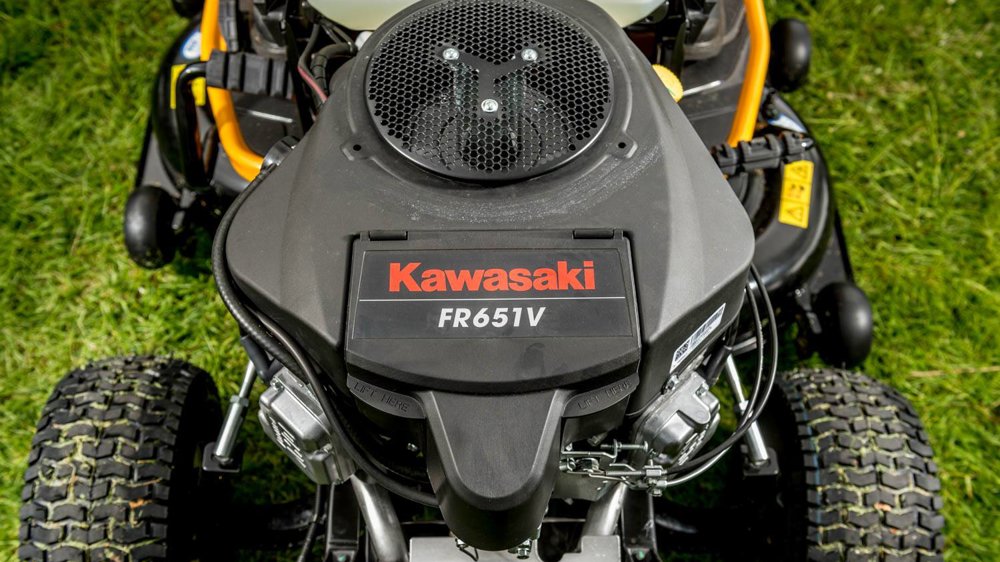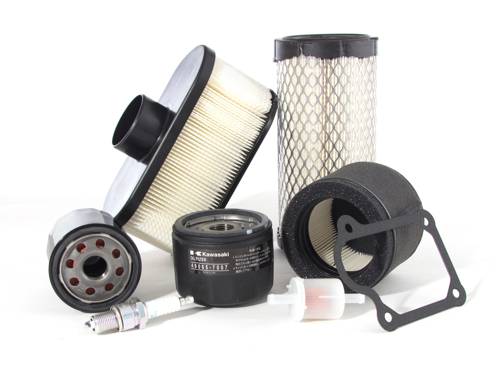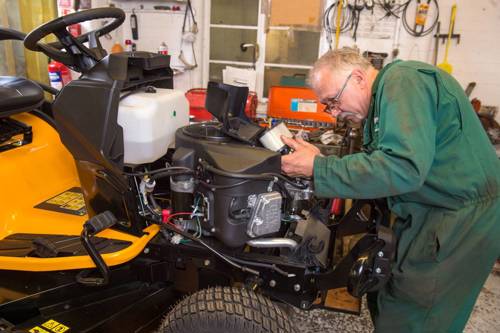4-stroke engine maintenance: a how-to guide
11 Apr 2023 Engines & Aftercare
Maximising your engine's performance and longevity requires regular maintenance: it can add years on to the life of an engine.
If a high-quality engine is an investment, you should do what you can to protect it. Keeping up with maintenance for your 4-stroke engine will help your equipment to perform to the best level it can.
For maintenance guidance specific to your engine, you should refer to your owner’s manual. For Kawasaki engines, they can be found here. Alternatively, find a Kawasaki dealer near you.
Detecting changes in the machine
Slight changes, like a new smell, a change in vibration or an increase in noise can be a sign that something is wrong. Use your senses and experience to tell if something has changed with your machine. It can be very subtle, but is always worth addressing.
To give you an example, one such incident occurred at an English Premier League football club, when the operator of a pedestrian mower sensed a change in the precision of the cutting through the vibrations of the machine.
It didn't affect the quality of the mowing in any major way, but it did impact cutting the pattern into the pitch. The mower was hesitating and the blade slowing down slightly; ultimately, an issue with the carburettor was discovered. If it had failed further it may have resulted in an improper air fuel mixture causing poor fuel economy or even engine damage. Without the operator paying attention to those small changes, it may have gone unnoticed.
General tips
While we will be going into in-depth maintenance tasks shortly, there are some simple things you can do to guarantee you are performing maintenance tasks correctly.
Here are some simple tips and reminders for 4-stroke engine maintenance:
- It may seem obvious, but don't delay routine servicing or skip the daily oil and air checks – when something breaks or does not perform correctly, it could often have been spotted beforehand.
- Check liquid levels on a flat surface. On an incline, the level reading will be inaccurate, showing more or less according to the way it's tilting. During normal deck inspection, tilting a walk-behind mower the wrong way can cause the carburettor to flood with fuel!
- Dry excess water from the machine after jet washing. When cleaning your machine, water can pool and damage the electrics. WD-40 is great to use post-wash as it displaces moisture and protects against electrical short circuits.
- Always consider where you put things – for example, don’t rest anything on the engine fan, as covering it will lead to overheating and can cause the engine to seize
- Don’t clean spark plugs with a steel wire brush. It leaves metal traces and will cause the plug to short out.
Use the correct oil and fuel
Again, this may seem obvious, but a surprising amount of people make the mistake of using the wrong fuel.
The workday can feel very long, especially when you're busy – putting two-stroke fuel into a four-stroke engine is an easy mistake to make when you're tired, or rushed. Marking up the cans and putting them in places far away from one another can help prevent this from happening.
Drain the engine of fuel if stored for over 30 days
Draining the fuel from the engine before long-term storage is increasingly important. In an effort to reduce CO2 emissions, ethanol is now added to fuel in amounts up to 10 percent. Ethanol is highly corrosive, so if left for long periods of time sitting in the engine unused, damage can occur.
You may have left fuel in your machines before without issue, but older machines were more resistant to corrosion. This was due to their use of chromium cadmium and lead in the carburettors; despite being useful for resisting corrosion, they are thankfully no longer used in equipment, as they're hazardous substances.
A combination of the change in fuel composition and the make-up of machines means it's more important than ever to drain your equipment before storage.
Use genuine parts

Purchasing Kawasaki Engines genuine parts takes away the risk of engine damage due to faulty parts. You know you're getting a part designed exactly to your engine's specifications, it's tried and tested, and made to improve performance, not cut costs.
In worst-case scenarios, using a non-genuine part can result in engine failure, but even a slight decrease in efficiency, by comparison, can slowly degrade your engine over time. Repairs and extra engine maintenance can quickly add up in terms of cost, as well as the headaches from avoidable machine downtime.
For more information on the difference between genuine and aftermarket parts, read the expert advice of Martin Cook and Dave Dunwoody, from the European Kawasaki Engines Parts and Technical team.
How often should you perform engine maintenance tasks?
Regular engine maintenance helps improve all engine functions, with benefits like improved fuel consumption, increased power and reduced risk of downtime. You should always check your engine manual for information relevant to your machine, as each will have different maintenance requirements and may not use the same parts. These should be safely kept onsite, although engine manufacturers usually have them available on their website, e.g. Kawasaki's Technical Downloads page
The below periodic maintenance chart is for an FR engine; specifically the FR 651, 691 and 730V engines. You should always bear in mind that charts such as these are only a guideline; particularly if you're working in dusty conditions, where you will need to perform certain maintenance tasks more often.
Find your nearest Kawasaki Engines dealer for parts and servicing.
Daily
- Check and add engine oil
- Check for loose or lost nuts and screws
- Check for fuel and oil leakage
- Check battery electrolyte level, if applicable
- Check or clean air inlet screen
Every 100 hours
- Clean the air cleaner paper element
- Clean dust and dirt from cylinder and cylinder head fins
- Tighten nuts and screws
- Change engine oil (every 100 hours or 1 year, whichever comes first)
- Clean and re-gap spark plugs
Every 200 hours
- Change oil filter
- Replace air cleaner paper element
Every 300 hours
IMPORTANT: Note that these tasks must be completed by a Kawasaki Engines authorised dealer. Find your nearest here.
- Clean combustion chamber
- Check and adjust valve clearance
- Clean and lap valve seating surface
Kawasaki recommends draining the fuel system if the engine is stored for more than 30 days.
4-stroke engine maintenance

Again, the instructions for this will differ according to your engine model. There will be similarities of course, but these instructions are designed for FR 651, 691 and 730V engines.
These are some of the more common maintenance tasks you may have to undertake for your four-stroke engine.
Oil change
An oil change must be conducted every 100 hours or per year, depending on which comes first.
Steps for an oil change in an FR engine:
- Run the engine to warm the oil
- Be sure the engine is level
- Stop the engine
- Remove the oil gauge (dipstick). Then remove the drain plug and drain the oil into a suitable container while the engine is warm. Do not do this while the engine is hot! Hot engine oil can cause severe burns. Allow the engine temperature to drop to warm rather than hot before draining and handling oil
- Install the oil drain plug
- Refill with fresh oil
- Check the oil level with the oil gauge (dipstick)
IMPORTANT: Be careful when disposing of used oil, as engine oil is a toxic substance. You can contact your local authorities to find out the best and approved ways to dispose of it, or if recycling is a potential option.
Oil filter change
Change the oil filter every 200 hours of operation. Similar to an oil change, you must wait for the engine temperature to drop before attempting to remove the oil filter.
- Drain the engine oil into a suitable container
- Rotate the oil filter anti-clockwise to remove it
- Coat a film of clean engine oil on the seal of the new filter
- Install the new filter, rotating it clockwise until the seal contacts the mounting surface. Then rotate the filter 3/4 turn more by hand
- Supply the engine oil as specified
- Run the engine for about three minutes, then stop the engine and check for any oil leakage around the filter
- Add oil to compensate for the oil level drop due to the oil filter capacity
Air filter paper element
You should clean the paper element of an air filter every 100 hours for an FR engine with average usage. Once you have reached 200 hours of use or it's been a year, you will need to replace it.
You can clean the paper element by gently tapping it to remove dust. If it's very dirty and this doesn't work, you will have to replace the air filter. You should never wash or oil the paper element, or use pressurised air to clean it.
Spark plug service
Clean or replace the spark plugs and reset spark plug gap every 100 hours of operation.
- Disconnect the spark plug caps from the spark plugs; remove the spark plugs
- Clean the electrodes by scraping with a non-metal brush to remove carbon deposits
- Inspect for cracked porcelain or other wear and tear. Replace the spark plug with a new one if necessary
- Check the spark plug gap and reset if necessary. The gap must be 0.75 mm. To change the gap, bend only the side–electrode, using a spark plug tool. Install and tighten the spark plugs to 22 N·m
- Connect the spark plug caps
Cooling System Cleaning
The entire cooling system should be checked and cleaned after every 100 hours of operation, but the rotary screen should be checked before each use, and any grass and debris cleaned away.
For the system clean, the cooling fins and inside of the engine shrouds will need to be checked, and any grass, dirt or debris removed. When cleaning, you will need to remove the air filter, loosen the bolts, and then remove the fan housing.
Be careful not to run the engine before all cooling system parts are reinstalled.
Need your engine to be serviced?
You should now have an idea of how often you should perform engine maintenance tasks and how they're completed, as well as some general maintenance tips, including things to look out for and how to perform tasks effectively.
Remember to always refer back to the owner’s manual for advice on routine maintenance tasks for your specific engine model; our examples were for a few engines in our FR series, but will differ according to the engine you own.
As we mentioned earlier, monitoring small changes and keeping up with regular maintenance can make a huge difference to the performance and lifespan of your engine. Putting the time and effort in to looking after your engine will help you in the long-run, as your engine will continue working to the level it should.
If you're due a service or need a maintenance task performed that you can't do yourself, you should contact your nearest Kawasaki dealer.
You may be interested in
-
How long do Kawasaki engines last?

-
A match made in heaven: how do we pair Kawasaki engines with the machines they power?

-
How do we guarantee quality at Kawasaki Engines? A behind-the-scenes look into our US manufacturing plants

-
Kawasaki Engines genuine parts and non-genuine aftermarket parts: what’s the difference?

-
Spot the difference: a side-by-side comparison of genuine and aftermarket parts.

-
Winter pre-storage preparation for your Kawasaki powered equipment







